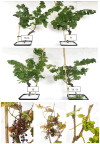Xylem Sap Mycobiota in Grapevine Naturally Infected with Xylella fastidiosa: A Case Study: Interaction of Xylella fastidiosa with Sclerotinia sclerotiorum
- PMID: 40647985
- PMCID: PMC12252444
- DOI: 10.3390/plants14131976
Xylem Sap Mycobiota in Grapevine Naturally Infected with Xylella fastidiosa: A Case Study: Interaction of Xylella fastidiosa with Sclerotinia sclerotiorum
Abstract
Grapevine (Vitis vinifera) is a key crop in Mediterranean agriculture, now increasingly threatened by Xylella fastidiosa subsp. Fastidiosa (Xff), the causal agent of Pierce's disease. This study investigated: (1) the diversity of culturable fungal endophytes in the xylem sap of naturally Xff-infected grapevines, and (2) the interaction between Xff and the pathogenic fungus Sclerotinia sclerotiorum identified in the sap. The xylem sap was collected from Cabernet Sauvignon vines in Mallorca, Spain, and fungal communities were characterized using culture-dependent methods. Both beneficial fungi (e.g., Aureobasidium pullulans, Rhodotorula mucilaginosa) and pathogenic species (e.g., S. sclerotiorum, Cladosporium sp., Alternaria alternata, and the Phoma complex) were isolated from both Xff-positive and Xff-negative plants, indicating similar community profiles. Although limited by small sample size, these findings offer preliminary evidence of complex ecological interactions between Xff and the xylem-associated mycobiota, with potential implications for grapevine health and disease development under varying environmental and management conditions. Further experiments under controlled conditions revealed that grapevines co-inoculated with Xff and S. sclerotiorum showed increased disease severity, suggesting a synergistic interaction. These preliminary results highlight the complex interplay between Xff and the fungal endophytic microbiome, which may modulate grapevine susceptibility depending on environmental and management conditions.
Keywords: Sclerotinia sclerotiorum; Xylella fastidiosa; cross-kingdom interactions; endophytic mycobiota; grapevine; synergism.
Conflict of interest statement
The authors declare that the research was conducted in the absence of any commercial or financial relationships that could be considered as a potential conflict of interest.
Figures








References
-
- Wells J.M., Raju B.C., Hung H.Y., Weisburg W.G., Mandelco-Paul L., Brenner D.J. Xylella fastidiosa gen. nov, sp. nov: Gram-negative, xylem-limited, fastidious plant bacteria related to Xanthomonas subsp. Int. J. Syst. Bacteriol. 1987;37:136–143. doi: 10.1099/00207713-37-2-136. - DOI
LinkOut - more resources
Full Text Sources
Miscellaneous

